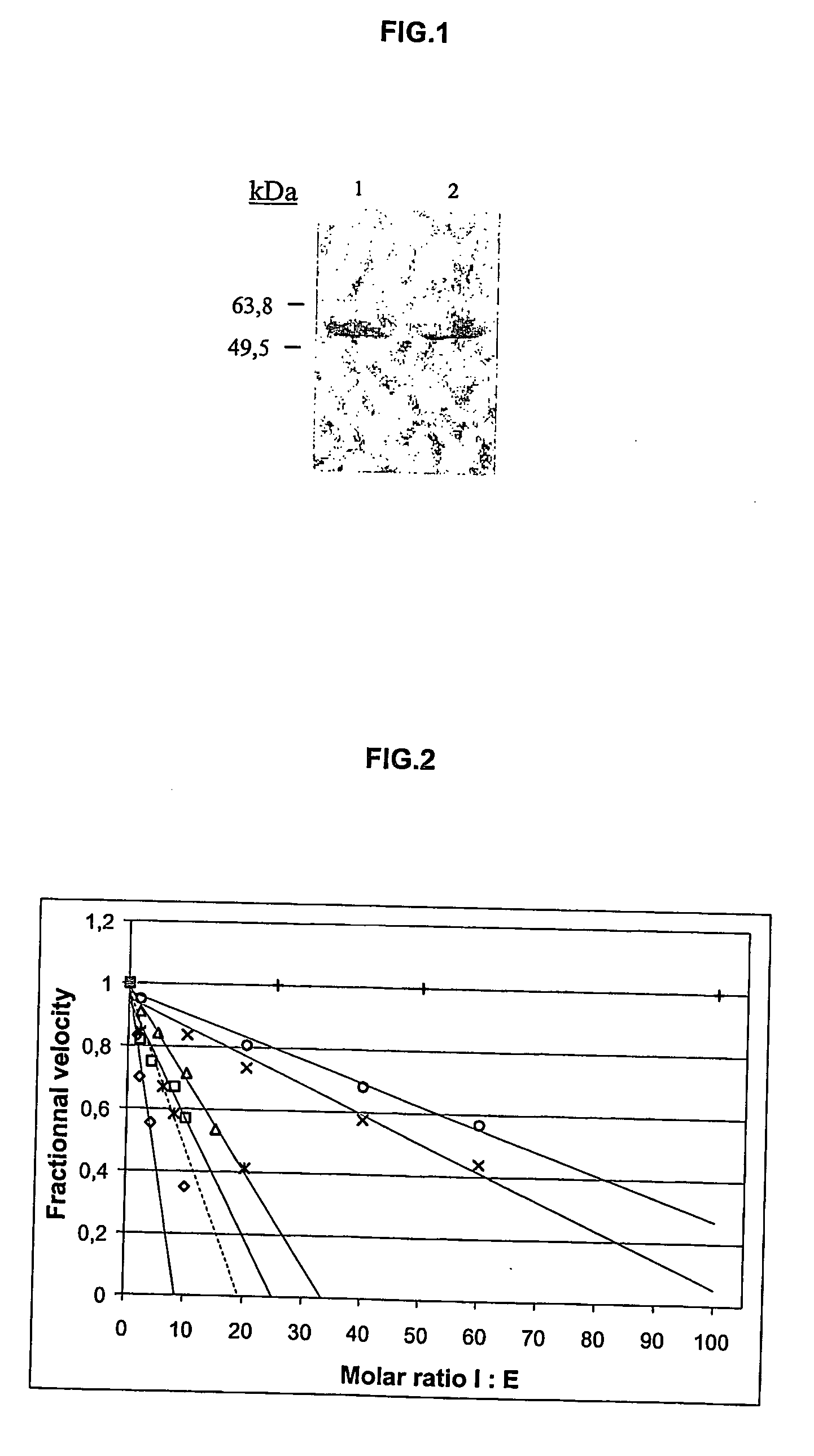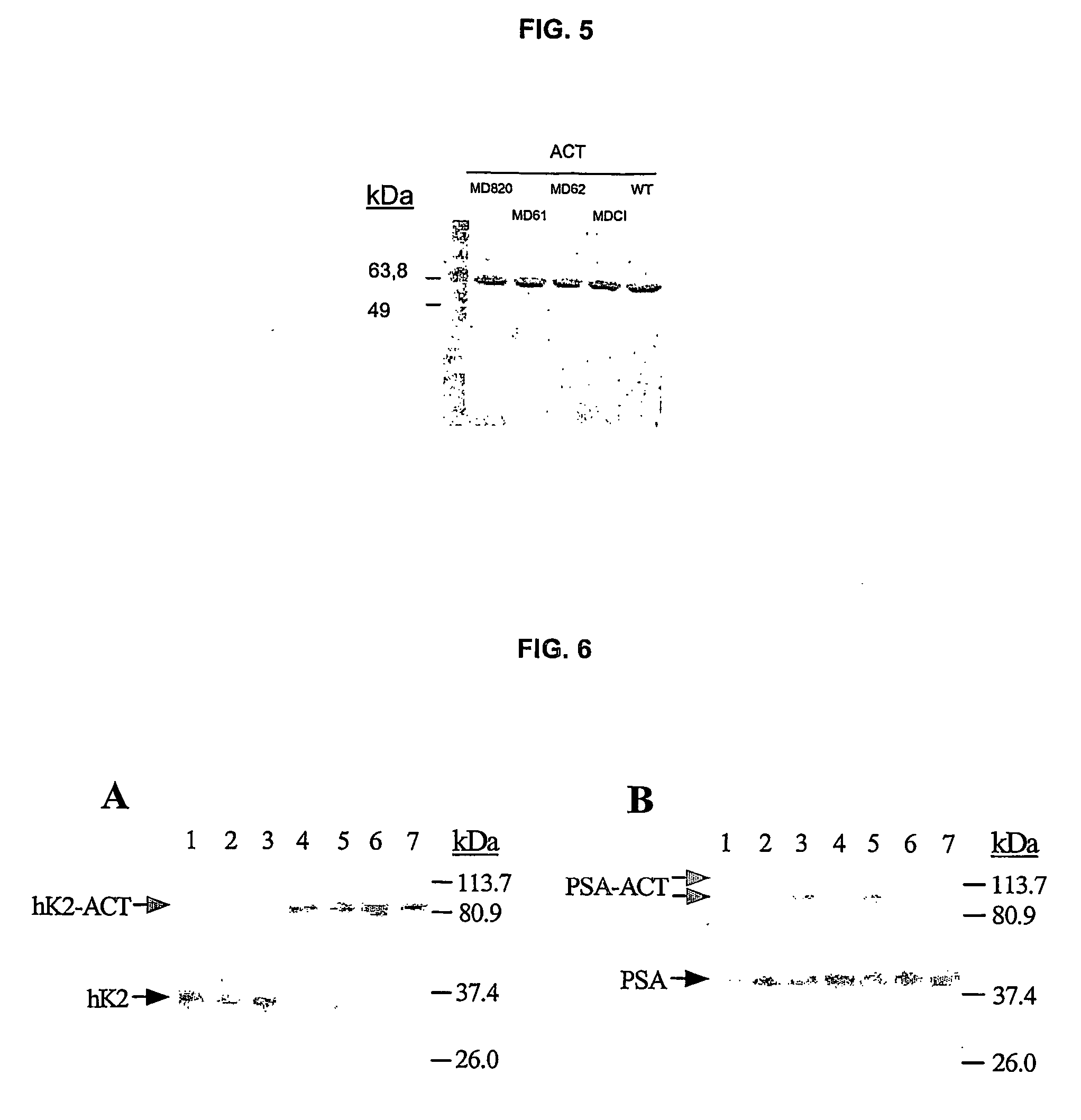Inhibitor proteins of a protease and use thereof
- Summary
- Abstract
- Description
- Claims
- Application Information
AI Technical Summary
Benefits of technology
Problems solved by technology
Method used
Image
Examples
example 1
Development of Recombinant ACT Inhibitors Specific to Human hK2 Using Phage Display Selected Substrates.
Material
[0142] hK2 and hK3 (PSA) were purified from human semen as previously described (Frenette G, Gervais Y, Tremblay R R, Dube J Y. 1998 “Contamination of purified prostate-specific antigen preparations by kallikrein hK2” J Urol 159, 1375-8), anti-hK2 and anti-PSA monoclonal antibodies were a gift from Professor R R Tremblay, Laval University, Canada. Human chymotrypsin (Chtr), urokinase plasminogen activator (uPA), human kallikrein hK1, human plasma kallikrein (PK), human neutrophil elastase (HNE) and commercial ACT (human plasma α1-antichymotrypsin) were purchased from Calbiochem. Z-Phe-Arg-AMC, Suc-Ala-Ala-Pro-Phe-AMC, Z-Gly-Gly-Arg-AMC, MeOSuc-Ala-Ala-Pro-Val-AMC were purchased from Calbiochem. CFP-TFRSA-YFP fluorescent substrate was developed as previously described (Mahajan N P et al. 1999 “Novel mutant green fluorescent protein protease substrates reveal the activat...
example 2
Development of Recombinant ACT Inhibitors Specific to Human hK2 and hK3 Proteases.
[0162] Residues P3-P3′ located in RSL structure of rACTWT were replaced by substrate pentapeptide coding for the RSL of Protein C Inhibitor (PCI) (Table VII) as described in example 1.
TABLE VIIAlignment of RSL (Reactive Serpin Loop) ofrecombinant serpins ACT, PCI and ACTPCIRSL sequencesSerpinP6P5P4P3P2P1P′1P′2P′3P′4P′5P′6rACTWTAmino acidVKITLLSALVETsequenceDNAGTCAAAATCACCCTCCTTTCTGCATTAGTGGAGGTCsequence(codon)rPCIWTAmino acidTIFTFRSARLNSsequencerACTPCIAmino acidVKITFRSALVET(MD CI)sequenceDNAGTCAAAATGACCTTTTCTGCATTAGTGGAGGTC(codon)
Plain type residues are common to rACTWT, bold and underlined residues correspond to substrate peptides relocated in RSL of ACT variants. The scissile bond in substrate peptides is designated by ↓ and putative cleavage site in serpins is marked by asterisks between the P1-P1′ residues.
[0163] Briefly, to produce the recombinant protein ACTPCI (MDCI), TG1 cells were transfo...
example 3
Inhibition of Tumor Growth by MD Inhibitors
3.1 Inhibition of Tumor Growth by MD62 and MD 67 Inhibitors
[0173] The androgen-independent human prostate adenocarcinoma cell line DU-145 was obtained from American Type Culture Collection. Retroviral technology was used to obtain DU145 cell transfected with hK2 gene (DU145 / hK2).
[0174] Exponentially growing DU145 / hK2 cells were collected and resuspended at a concentration of 7.5×107 cells / ml in DMEM (Invitrogen) containing 1 or 10 μg of inhibitors. This cell suspension was mixed with matrigel (BD Biosciences) at a 1:2 ratio and injected subcutaneously (3×106 cells / 40 μl) into the right and left flank of 8 week old male athymic Swiss nude mice (two mice / group). Each mouse was inoculated at two sites.
[0175] At days 6, 12 and 18 following tumor inoculation, 50 or 10 g of MD62, MD67 or 100 μg or 10 μg of ACT-WT were injected subcutaneously. At days 24, 30, 33, 36, 39 and 41 following tumor inoculation, 25 or 5 μg of inhibitors (MD62 and MD...
PUM
| Property | Measurement | Unit |
|---|---|---|
| Temperature | aaaaa | aaaaa |
| Temperature | aaaaa | aaaaa |
| Time | aaaaa | aaaaa |
Abstract
Description
Claims
Application Information
 Login to View More
Login to View More - R&D
- Intellectual Property
- Life Sciences
- Materials
- Tech Scout
- Unparalleled Data Quality
- Higher Quality Content
- 60% Fewer Hallucinations
Browse by: Latest US Patents, China's latest patents, Technical Efficacy Thesaurus, Application Domain, Technology Topic, Popular Technical Reports.
© 2025 PatSnap. All rights reserved.Legal|Privacy policy|Modern Slavery Act Transparency Statement|Sitemap|About US| Contact US: help@patsnap.com



